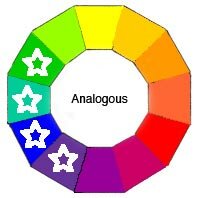Analogous Color Schemes

An Analogous Color Scheme features three or more Hues which are positioned next to each other on the Color Wheel.
Simply choose any color as your main Mother Color. Then select two or three colors on either side of it. They all share similarities at their root and will be fairly easy to harmonize.
In this example, the two Hues farthest from each other are Green and Blue/Violet, yet they are still ‘cousins’. Green is a Secondary Color made by mixing Blue and Yellow. Of course Blue/Violet also contains Blue which makes them ‘related through marriage’.
In this case the Yellow used to mix Green is also the Complementary of Violet which is mixed with Blue/Violet. This makes it fairly easy to lower the intensity when needed.
If you were to simply use these bright Hues together, it would create a harmonious effect. But it would be very bright. This might be suitable for a child’s playroom or a graphic. For most color schemes, it’s more likely you’d want to mix and tone them down for added sophistication.
Example of an Analogous Color Scheme

Here Blue/Green is the Mother Color shown in the center paint swatch. The pure Green, Blue and Blue/Violet Hues are on the top.
By adding a tiny bit of Blue/Green to each pure Hue, you get much more subtle versions, as seen on the bottom row. These new paint colors aren’t altered very much because they’re so close to begin with. But they are far more pleasing and harmonious to the eye than the original tube paint.
For a wider range of paint colors and to create neutrals, add varying amounts of White, Black or Gray to tint, shade or tone down the colors even more.
You have the option of choosing any of the other three colors as your Mother Color. For example, if you chose Blue/Violet instead the result would be entirely different. As long as you don’t add another Hue, they will always go together.
An Analogous Color Scheme is a very simple, fairly goof-proof and sophisticated palette.
Painting Tips for an Analogous Color Scheme
- Play up your dominant Mother Color in the bright accent areas. Add a pinch of one other color in your scheme to harmonize.
- Darken some of your altered Hues to create Shades with black. Lighten others to make Tints and add Gray to tone down the brights for interesting variations.
- Remember to mix gradually or all your colors will end up looking the same.
- Experiment with various balance of mixtures on a piece of paper or in your sketchbooks before you start working on a project. It will give you a better feel of the full range of colors you can achieve.
Check out these Color Schemes
Complementary
Near Complementary
Triad
Complementary Triad
Modified Triad

